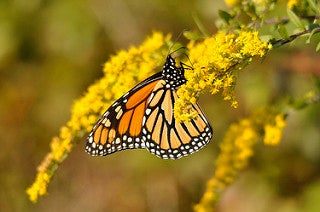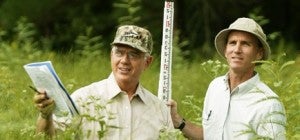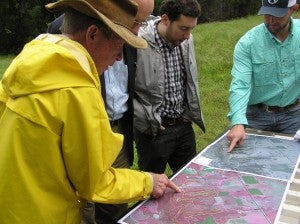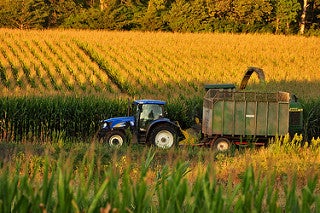
Could the monarch butterfly face the same plight of the passenger pigeon? Read more in Modern Farmer.
When I think about what motivates me as a conservationist, I often reflect on the bird species we’ve lost – the Carolina parakeet, the ivory-billed woodpecker, the passenger pigeon.
I remember these species when I work to create pathways to prevent extinction for today’s at-risk wildlife – the lesser prairie-chicken, the golden-cheeked warbler and the greater sage-grouse.
But it’s not just the birds that inspire me. It’s also the people.
My role as director of conservation strategy and habitat markets often requires me to cultivate partnerships with ranchers, farmers, oilmen and large multinational corporations. It’s incredibly satisfying to work with this diverse set of stakeholders to find common ground. Sure, we all have different interests driving us, but I am steadfast in my belief that we can protect natural resources, while at the same time enabling the responsible production of food, fuel and fiber.
An evolution of conservation strategies

David Wolfe (right) has worked with countless stakeholders across the country in developing conservation solutions for at-risk wildlife – from golden-cheeked warblers in Texas to greater sage-grouse in Colorado.
In my 16 years at EDF, I’ve worked on many different species in various parts of the country with drastically different landscapes and habitat types. Across all of this work, one thing has remained true, which is that financial incentives in concert with regulatory assurances and cultivation of a stewardship ethic drive the fastest, strongest conservation.
In the early days we focused on the development of regulatory assurances in the form of Safe Harbor agreements, which are now used by a wide variety of organizations and state agencies to recruit landowners for voluntary conservation on non-federal lands. These agreements assure landowners that the U.S. Fish and Wildlife Service will not require any additional or different management activities without their consent.
Dozens of species and more than 4 million acres are being conserved under Safe Harbor agreements today.
Following the successes of initial Safe Harbor agreements we identified sources of funding (for example the Farm Bill and philanthropic foundations) that could be used for restoring and conserving habitat. We would then identify individual landowners who, in return for credit payments, would be willing to engage in habitat restoration or conserve existing habitats.
The evolution of habitat exchanges

Dr. Gene Murph points to the best golden-cheeked warbler habitat on his property. Dr. Murph participated in the Fort Hood Recovery Credit System, earning new revenue for conservation activites that improved the bird’s habitat. Read more >>
As my colleagues and I witnessed the success of Safe Harbor and early conservation credit markets, we quickly realized the potential to bring these markets to scale to work for multiple species in vast landscapes across the country.
Particularly, we realized the opportunity and imperative to create a larger market to more substantially engage the agricultural community. Because if a few dozen ranchers could help protect a bird found only in the oak-juniper woodlands of central Texas, surely the same strategy could be applied to the 11-state range of the greater sage-grouse.
In places like Colorado, Nevada and Wyoming, habitat exchanges are working to engage energy companies, agriculture leaders and states to provide a fast and efficient means of moving mitigation dollars from oil and gas operations to ranchers with the most potential for restoring and conserving sagebrush habitat. Already, more than $2 million is set to flow to Nevada ranchers over the course of the next two years to protect sage-grouse habitat.
Up next: the monarch butterfly
As if working across an 11-state range wasn’t challenging enough, I am now leading the effort to develop a habitat exchange for the monarch butterfly — the iconic North American species with a trans-continental migration fanning from Canada to Mexico.

Farmers who avoid the conversion of marginal lands to cropland can earn conservation credits for leaving these lands fallow, or for planting milkweed on roadsides and field edges. Learn more >>
Over the past couple of decades, we have seen the widespread adoption of genetically modified crops that are resistant to glyphosate herbicides. As a result, glyphosate application has increased dramatically, causing milkweed, which the monarch needs to feed and breed, to disappear from the agricultural landscape. The result: an alarming decrease in the monarch population, to the point where the butterfly has been petitioned for protection under the Endangered Species Act.
If the monarch is added to the endangered species list, the use of herbicides might be restricted, which would impact farmers and herbicide producers alike. To avoid the need to list the monarch, we’re encouraging chemical companies to proactively invest in monarch habitat restoration, and we’re encouraging farmers to implement conservation measures to restore milkweed on their lands, for which they would receive credits that can be sold to the companies.
I’m optimistic about the potential for habitat exchanges to transform how landowners manage their properties and how corporations think about their development activities and associated environmental impacts. If all of these stakeholders become more sustainably invested in the conservation of wildlife and ecosystems, I will consider my work over the last few years to be a big success.
Related:
Program helps Texas ranchers save endangered bird, but more conservation is needed >>
Operation Warbler: Fort Hood and local ranchers team up to save bird >>
From California to Idaho: Protecting rural pit stops on the monarch butterfly’s great migration >>









